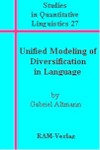Studies in Quantitative Linguistics 27
„Unified Modeling of Diversification in Language“
Preface
Quantification is a most natural development in all sciences. At the beginning, it is not very ripe but it is better to do something than to adhere to a tradition. One can distinguish several steps in quantification: (1) The use of quantitative concepts, beginning with decisions, and formalizations; then trying to ascribe to the phenomena some numbers or degrees; (2) measuring the phenomenon, especially properties. It must be noted that the properties – whatever they are – are our conceptual creations representing the reality “for us”; (3) expressing mathematically the fact found, and performing some kind of modeling; (4) testing the model on data – an enterprise that will never be finished; (5) joining the phenomenon with other phenomena, creating and deriving of hypotheses, and constructing a theory; and ultimately (6) the unification of the modeling and its simplification as far as possible.
We find all of these levels in current quantitative linguistics. In the present book we try to make a step in the last stage, namely to perform a simplification concerning classes of linguistic objects. We have collected some of the available published literature – it is enormous – and let the reader continue fitting the simple function we propose.
The approach does not mean that all the enedeavours by Zipf, Mandelbrot, etc. are not correct. On the contrary, we merely bring to them a simple differential equation which is easier to interpret than the more complex ones, but all of them belong to the same unified theory. Neither does it mean that we have discovered more truth. Truth is not concealed behind formulae. They merely help us to capture the reality and to draw mechanically consequences using the rules of mathematics. But none of our models is part of the reality.
We hope that those who have many sets of data at their disposal will test the given proposal. If the data are bell shaped, the simple formula does not work. But one can add something to the differential equation and interpret it synergetically. We are persuaded that all relations in language are very simple. We do not know them but we try to capture them viribus unitis.
Gabriel Altmann

